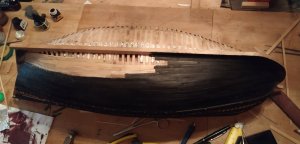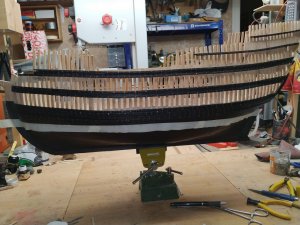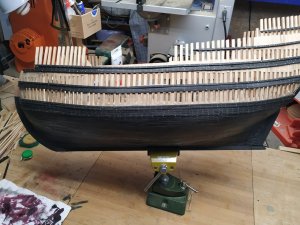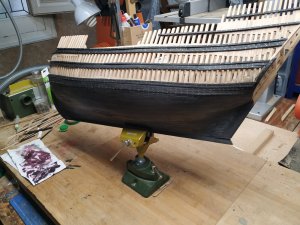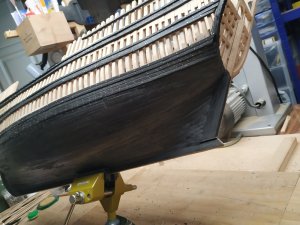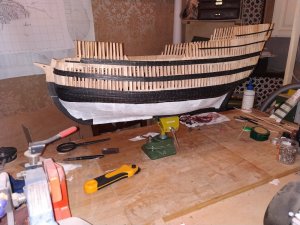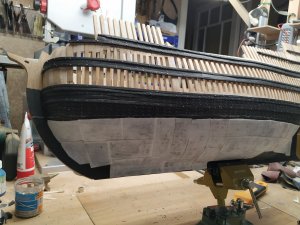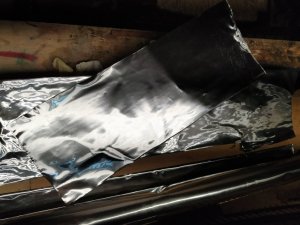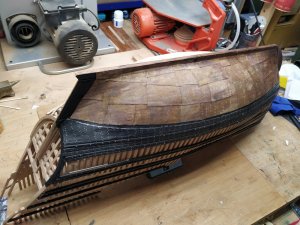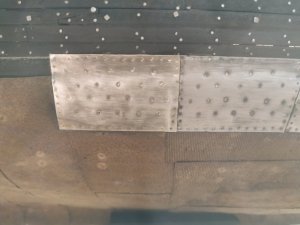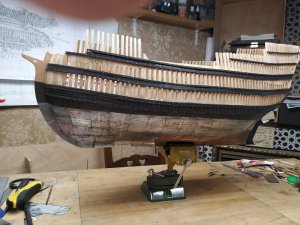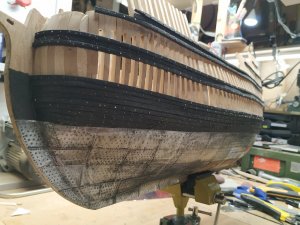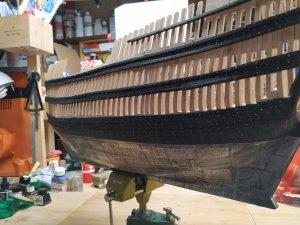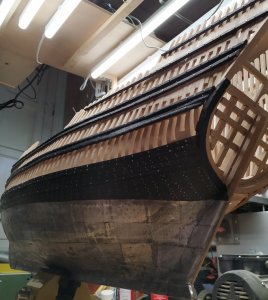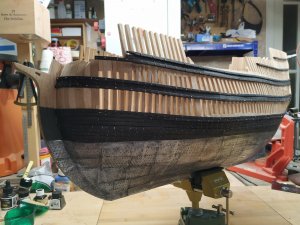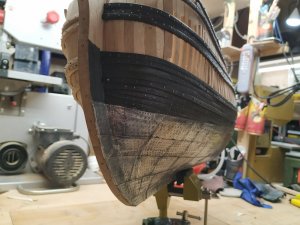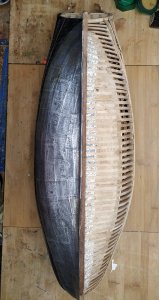-

Win a Free Custom Engraved Brass Coin!!!
As a way to introduce our brass coins to the community, we will raffle off a free coin during the month of August. Follow link ABOVE for instructions for entering.
-

PRE-ORDER SHIPS IN SCALE TODAY!
The beloved Ships in Scale Magazine is back and charting a new course for 2026!
Discover new skills, new techniques, and new inspirations in every issue.
NOTE THAT OUR FIRST ISSUE WILL BE JAN/FEB 2026
You are using an out of date browser. It may not display this or other websites correctly.
You should upgrade or use an alternative browser.
You should upgrade or use an alternative browser.
SPANISH GALLEON XVII. GALEON DEL AZOGUE [COMPLETED BUILD]
- Thread starter ramonolivenza
- Start date
- Watchers 65
-
- Tags
- completed build
it's a pre-leaded phase. The Spanish galleons, especially those who were going to sail through tropical waters, were leaded in their underwater part to protect themselves from the(teredo navalis). The lead leaf was not put directly on the wood, but it was previously put on a layer of tarred cloth. The function of this cloth was to protect even more the ship floor since many times the sheets of lead were torn by rubbing cables etc ... This leaded, curiously not seen in models of galleons (I have complained about the few models of quality galleons that you see). I am in the first phase, cloth and tarr, then I will fill it with lead sheet... This will not be seen on this side, on the other side, the one that is open, if the process will be appreciated.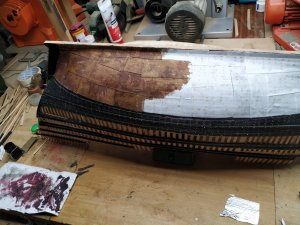

For those who where wonder what is to do with 'veldig bra' - it is Very Good in NorwegianVELDIG BRA
Hi Ramon,
Very interesting proces.
Very interesting proces.
Thanks...
Hi Ramon, hreat work. Are you usong real lead for this or an alternative like oxidated aluminium tape?
Tin (Sn) leaf and Super BlueHi Ramon, hreat work. Are you usong real lead for this or an alternative like oxidated aluminium tape?
Last edited:
Hago algunas aclaraciones generales dada la perplejidad que ha ocasionado mi forro de plomo.
El forro de cobre de la obra viva surge en Inglaterra en la segunda mitad del siglo Xviii. Sin embargo, 250 años antes en España se empieza a proteger con plomo la obra viva de los Galeones de la Carrera de Indias. La razón de esto es la existencia del Teredo Navalis, molusco de las aguas cálidas que destruía la madera, especialmente la madera europea. Para proteger los cascos que debían navegar por aguas tropicales se invento cubrir la carena con láminas de plomo.
Este recurso técnico no tiene nada que ver con el cobre del XVIII.. Estamos hablando de siglo Xvi y xvii.
El inventor de este sistema fue un joyero de nombre Antonio Hernández. La primera nave así emplomada fue la carabela Santa Ana, en 1514, que firmo parte de la expedición de Pedrarias, gobernador de Nicaragua a Panamá. Dicho Antonio Hernández obtuvo el cargo de emplomador con una asignación de 25000 maravedies. Posteriormente adoptaron este sistema ingleses, holandeses y franceses. Boudriot cita al menos dos Buques franceses del xvii que lo llevaron.
Las planchas de plomo se adquirían en el xvii en Holanda y su grosor era de 5/7 mm. Bajo ellas se ponía una capa de tela embreada o alquitranada.
Se encuentra documentación en la obra de Cesáreo Fernández Duro, en "En la mar madera", en la de Enrique García Torralba sobre las Fragatas Españolas y en la de Gervasio de Antiñano (accesible en el archivo de la Smithsonian).
Curiosamente, aunque era un sistema amplíamente utilizado a largo del siglo xvi y xvii, no lo he visto reproducido en ningún modelo.
El forro de cobre de la obra viva surge en Inglaterra en la segunda mitad del siglo Xviii. Sin embargo, 250 años antes en España se empieza a proteger con plomo la obra viva de los Galeones de la Carrera de Indias. La razón de esto es la existencia del Teredo Navalis, molusco de las aguas cálidas que destruía la madera, especialmente la madera europea. Para proteger los cascos que debían navegar por aguas tropicales se invento cubrir la carena con láminas de plomo.
Este recurso técnico no tiene nada que ver con el cobre del XVIII.. Estamos hablando de siglo Xvi y xvii.
El inventor de este sistema fue un joyero de nombre Antonio Hernández. La primera nave así emplomada fue la carabela Santa Ana, en 1514, que firmo parte de la expedición de Pedrarias, gobernador de Nicaragua a Panamá. Dicho Antonio Hernández obtuvo el cargo de emplomador con una asignación de 25000 maravedies. Posteriormente adoptaron este sistema ingleses, holandeses y franceses. Boudriot cita al menos dos Buques franceses del xvii que lo llevaron.
Las planchas de plomo se adquirían en el xvii en Holanda y su grosor era de 5/7 mm. Bajo ellas se ponía una capa de tela embreada o alquitranada.
Se encuentra documentación en la obra de Cesáreo Fernández Duro, en "En la mar madera", en la de Enrique García Torralba sobre las Fragatas Españolas y en la de Gervasio de Antiñano (accesible en el archivo de la Smithsonian).
Curiosamente, aunque era un sistema amplíamente utilizado a largo del siglo xvi y xvii, no lo he visto reproducido en ningún modelo.
Many thanks, Ramon for explaining in great details history of lead sheets covering hulls. below is the English translation (Thanks Google translate!)Hago algunas aclaraciones generales dada la perplejidad que ha ocasionado mi forro de plomo.
El forro de cobre de la obra viva surge en Inglaterra en la segunda mitad del siglo Xviii. Sin embargo, 250 años antes en España se empieza a proteger con plomo la obra viva de los Galeones de la Carrera de Indias. La razón de esto es la existencia del Teredo Navalis, molusco de las aguas cálidas que destruía la madera, especialmente la madera europea. Para proteger los cascos que debían navegar por aguas tropicales se invento cubrir la carena con láminas de plomo.
Este recurso técnico no tiene nada que ver con el cobre del XVIII.. Estamos hablando de siglo Xvi y xvii.
El inventor de este sistema fue un joyero de nombre Antonio Hernández. La primera nave así emplomada fue la carabela Santa Ana, en 1514, que firmo parte de la expedición de Pedrarias, gobernador de Nicaragua a Panamá. Dicho Antonio Hernández obtuvo el cargo de emplomador con una asignación de 25000 maravedies. Posteriormente adoptaron este sistema ingleses, holandeses y franceses. Boudriot cita al menos dos Buques franceses del xvii que lo llevaron.
Las planchas de plomo se adquirían en el xvii en Holanda y su grosor era de 5/7 mm. Bajo ellas se ponía una capa de tela embreada o alquitranada.
Se encuentra documentación en la obra de Cesáreo Fernández Duro, en "En la mar madera", en la de Enrique García Torralba sobre las Fragatas Españolas y en la de Gervasio de Antiñano (accesible en el archivo de la Smithsonian).
Curiosamente, aunque era un sistema amplíamente utilizado a largo del siglo xvi y xvii, no lo he visto reproducido en ningún modelo.
I make some general clarifications given the perplexity caused by my lead lining. The copper lining of the living work emerges in England in the second half of the eighteenth century. However, 250 years earlier in Spain, the living work of the Gallegos de la Carrera de Indias began to be protected with lead. The reason for this is the existence of Teredo Navalis, a mollusc of warm waters that destroyed wood, especially European wood. To protect the hulls that had to navigate through tropical waters, it was invented to cover the hull with sheets of lead. This technical resource has nothing to do with the copper of the XVIII .. We are talking about the sixteenth and seventeenth centuries. The inventor of this system was a jeweler named Antonio Hernández. The first ship so leaned was the caravel, Santa Ana, in 1514, which signed part of the expedition of Pedrarias, governor of Nicaragua to Panama. Said Antonio Hernandez obtained the position of emplomador with an assignment of 25000 maravedis. Later they adopted this system English, Dutch, and French. Boudriot cites at least two French ships of the seventeenth that took him. The lead plates were purchased in the seventeenth century in Holland and their thickness was 5/7 mm. Under them, a layer of tarred or tarred cloth was put on. Documentation is found in the work of Cesáreo Fernández Duro, in "En la mar Madera", in that of Enrique García Torralba on the Spanish Frigates and in that of Gervasio de Antiñano (accessible in the Smithsonian archive). Curiously, although it was a system widely used throughout the sixteenth and seventeenth centuries, I have
I love your model and your work - and we learn a lot about the spanish ship construction history - Many Many Thanks for sharing
En torno al galeon español, hay mucha confusión. El galeón español – y concretamente los grandes galeones de la “Carrera de Indias”, (“Almirantas, Capitanas, Galeón del Azogue, Galeón de la Plata etc”) son barcos muy característicos fruto de unas técnicas de construcción propias de España y que responden a una necesidades muy concretas: gran capacidad de carga, solidez y fortaleza, uso mixto militar/comercial, navegación por aguas tropicales, poco calado...
Las técnicas de construcción aunan tradición del norte de España con influencias mediterraneas y portuguesas. Debían de tener gran capacidad para traer y llevar de las Indias (América) mercancias en la mayor cantidad posible. Debían ser muy solidas, fuertes y armadas pues transportaban mercancías valiosisimas; a la ida, azogue (mercurio) de las minas de Almadén (España) indispensable para procesar el oro y la plata americana; a la vuelta el oro y la plata de América así como las riquezas de Filipinas que llegaban en el “Galeón de Manila” a Nueva España (Méjico) y de ahí se embarcaban para España. Debían defenderse de Ingleses Holandeses y Franceses (y lo hicieron con éxito durante siglos). En tiempo de guerra servían de buques de guerra para la Armada.
Debían navegar por aguas tropicales, Golfo de México y Caribe, por lo que debían defenderse de la plaga del Teredo Navalis (de ahí el plomo).
Una caracteristica determinante de estos galeones es el calado; los galeones Españoles debían de salir y llegar, NECESARIAMENTE, de Sevilla, por el monopolio de la “Casa de Contratación de la Indias”. Eso implicaba traspasar la “La Barra de Sanlucar” un bajó de arena, y remontar el rio Guadalquivir. En Mexico existía un problema parecido con los arrecifes de San Juan de Ulúa. Hasta el siglo XVIII en que se trasladó la cabecera de la “Carrera de Indias” a la ciudad de Cadiz, los galeones tenían un delicado equilibrio entre calado y capacidad.
El resultado de todo esto es una nave peculiar distinta de los galeones ingleses (mucho mas pequeños y ágiles) y holandeses (sistema constructivo muy distinto aunque con algunos puntos en comun por las necesidades de calado y por la proximidad ibérica por Flandes)
Around the Spanish galleon, there is much confusion. The Spanish galleon - and specifically the great galleons of the "Carrera de Indias", ("Almirantas, Capitanas, Gallego del Azogue, Galleon de la Plata, etc.") are very characteristic boats, the result of construction techniques typical of Spain and that respond to a very specific needs: large load capacity, strength and fortress, mixed military / commercial use, navigation through tropical waters, little draft ...
The construction techniques combine tradition of northern Spain with Mediterranean and Portuguese influences. They must have great capacity to bring and carry from the Indies (America) merchandise in as much as possible. They had to be very solid, strong and armed because they transported valuable goods; on the way out, “azogue” (mercury) from the Almadén mines (Spain), indispensable for processing American gold and silver; to the return the gold and the silver of America as well as the riches of the Philippines that arrived in the "Galleon of Manila" to New Spain (Mexico) and from there they embarked for Spain. They had to defend themselves from Dutch and French English (and they did it successfully for centuries). In time of war they served as warships for the Armada.
They had to navigate through tropical waters, the Gulf of Mexico and the Caribbean, so they had to defend themselves from the plague of Teredo Navalis (hence the lead).
A defining characteristic of these galleons is the draft; the Spanish galleons had to leave and arrive, NECESSARILY, from Seville, for the monopoly of the "Casa de Contratación de la Indias". That meant crossing the "La Barra de Sanlucar" a sand drop, and go up the Guadalquivir river. In Mexico there was a similar problem with the reefs of San Juan de Ulúa. Until the eighteenth century when the head of the "Carrera de Indias" was moved to the city of Cadiz, the galleons had a delicate balance between draft and capacity.
The result of all this is a peculiar ship different from the English galleons (much smaller and agile) and Dutch (construction system very different but with some points in common for the needs of draft and the Iberian proximity to Flanders)
Las técnicas de construcción aunan tradición del norte de España con influencias mediterraneas y portuguesas. Debían de tener gran capacidad para traer y llevar de las Indias (América) mercancias en la mayor cantidad posible. Debían ser muy solidas, fuertes y armadas pues transportaban mercancías valiosisimas; a la ida, azogue (mercurio) de las minas de Almadén (España) indispensable para procesar el oro y la plata americana; a la vuelta el oro y la plata de América así como las riquezas de Filipinas que llegaban en el “Galeón de Manila” a Nueva España (Méjico) y de ahí se embarcaban para España. Debían defenderse de Ingleses Holandeses y Franceses (y lo hicieron con éxito durante siglos). En tiempo de guerra servían de buques de guerra para la Armada.
Debían navegar por aguas tropicales, Golfo de México y Caribe, por lo que debían defenderse de la plaga del Teredo Navalis (de ahí el plomo).
Una caracteristica determinante de estos galeones es el calado; los galeones Españoles debían de salir y llegar, NECESARIAMENTE, de Sevilla, por el monopolio de la “Casa de Contratación de la Indias”. Eso implicaba traspasar la “La Barra de Sanlucar” un bajó de arena, y remontar el rio Guadalquivir. En Mexico existía un problema parecido con los arrecifes de San Juan de Ulúa. Hasta el siglo XVIII en que se trasladó la cabecera de la “Carrera de Indias” a la ciudad de Cadiz, los galeones tenían un delicado equilibrio entre calado y capacidad.
El resultado de todo esto es una nave peculiar distinta de los galeones ingleses (mucho mas pequeños y ágiles) y holandeses (sistema constructivo muy distinto aunque con algunos puntos en comun por las necesidades de calado y por la proximidad ibérica por Flandes)
Around the Spanish galleon, there is much confusion. The Spanish galleon - and specifically the great galleons of the "Carrera de Indias", ("Almirantas, Capitanas, Gallego del Azogue, Galleon de la Plata, etc.") are very characteristic boats, the result of construction techniques typical of Spain and that respond to a very specific needs: large load capacity, strength and fortress, mixed military / commercial use, navigation through tropical waters, little draft ...
The construction techniques combine tradition of northern Spain with Mediterranean and Portuguese influences. They must have great capacity to bring and carry from the Indies (America) merchandise in as much as possible. They had to be very solid, strong and armed because they transported valuable goods; on the way out, “azogue” (mercury) from the Almadén mines (Spain), indispensable for processing American gold and silver; to the return the gold and the silver of America as well as the riches of the Philippines that arrived in the "Galleon of Manila" to New Spain (Mexico) and from there they embarked for Spain. They had to defend themselves from Dutch and French English (and they did it successfully for centuries). In time of war they served as warships for the Armada.
They had to navigate through tropical waters, the Gulf of Mexico and the Caribbean, so they had to defend themselves from the plague of Teredo Navalis (hence the lead).
A defining characteristic of these galleons is the draft; the Spanish galleons had to leave and arrive, NECESSARILY, from Seville, for the monopoly of the "Casa de Contratación de la Indias". That meant crossing the "La Barra de Sanlucar" a sand drop, and go up the Guadalquivir river. In Mexico there was a similar problem with the reefs of San Juan de Ulúa. Until the eighteenth century when the head of the "Carrera de Indias" was moved to the city of Cadiz, the galleons had a delicate balance between draft and capacity.
The result of all this is a peculiar ship different from the English galleons (much smaller and agile) and Dutch (construction system very different but with some points in common for the needs of draft and the Iberian proximity to Flanders)
Otra diferencia importante es la estética. Los galeones españoles tenían una estética mas austera que los ingleses y los holandeses. Una decoración mucho mas sobria.
Desde el punto de vista práctico, los galeones españoles eran lentos y poco maniobrables mientras que lo ingleses y holandeses eras muy manejables y rápido. Por el contrario los españoles eran fortalezas flotantes inexpugnables y fuertemente armados. En mas de dos siglos, se perdieron galeones por huracanes, averías etc, pero muy muy pocas veces fueron capturados. Tambien influyó en esto el sistema de convoys y la protección de los mismos con la “Flota de Tierra Firme” hasta Azores y luego la “Flota de la Mar Oceana”.
En su evolución los galeones españoles se quedaron atrás. Mientras que los navíos ingleses y holandeses, como consecuencia de las guerras angloholandesas del XVII entraron en una carrera de aumento de tamaño, velocidad y armamento, los españoles mantuvieron su exitosa formula que acabó por volverse obsoleta. En el siglo XVIII ya se revolucionó la construccion naval española y desapareció el galeón clásico.
Another important difference is the aesthetics. The Spanish galleons had a more austere aesthetic than the English and the Dutch. A much more sober decoration.
From a practical point of view, the Spanish galleons were slow and unmannelable while the English and Dutch were very manageable and fast. On the contrary, the Spaniards were impregnable and heavily armed floating fortresses. In more than two centuries, galleons were lost due to hurricanes, breakdowns, etc., but very seldom were they captured. This was also influenced by the convoy system and the protection of the same with the "Tierra Firme Fleet" until the Azores and then the "Oceana Sea Fleet".
In their evolution the Spanish galleons were left behind. While the English and Dutch ships, as a result of the Anglo-Dutch wars of the seventeenth entered a race of increase in size, speed and armament, the Spaniards maintained their successful formula that ended up becoming obsolete. In the 18th century, Spanish naval construction was revolutionized and the classic galleon disappeared.
Desde el punto de vista práctico, los galeones españoles eran lentos y poco maniobrables mientras que lo ingleses y holandeses eras muy manejables y rápido. Por el contrario los españoles eran fortalezas flotantes inexpugnables y fuertemente armados. En mas de dos siglos, se perdieron galeones por huracanes, averías etc, pero muy muy pocas veces fueron capturados. Tambien influyó en esto el sistema de convoys y la protección de los mismos con la “Flota de Tierra Firme” hasta Azores y luego la “Flota de la Mar Oceana”.
En su evolución los galeones españoles se quedaron atrás. Mientras que los navíos ingleses y holandeses, como consecuencia de las guerras angloholandesas del XVII entraron en una carrera de aumento de tamaño, velocidad y armamento, los españoles mantuvieron su exitosa formula que acabó por volverse obsoleta. En el siglo XVIII ya se revolucionó la construccion naval española y desapareció el galeón clásico.
Another important difference is the aesthetics. The Spanish galleons had a more austere aesthetic than the English and the Dutch. A much more sober decoration.
From a practical point of view, the Spanish galleons were slow and unmannelable while the English and Dutch were very manageable and fast. On the contrary, the Spaniards were impregnable and heavily armed floating fortresses. In more than two centuries, galleons were lost due to hurricanes, breakdowns, etc., but very seldom were they captured. This was also influenced by the convoy system and the protection of the same with the "Tierra Firme Fleet" until the Azores and then the "Oceana Sea Fleet".
In their evolution the Spanish galleons were left behind. While the English and Dutch ships, as a result of the Anglo-Dutch wars of the seventeenth entered a race of increase in size, speed and armament, the Spaniards maintained their successful formula that ended up becoming obsolete. In the 18th century, Spanish naval construction was revolutionized and the classic galleon disappeared.


